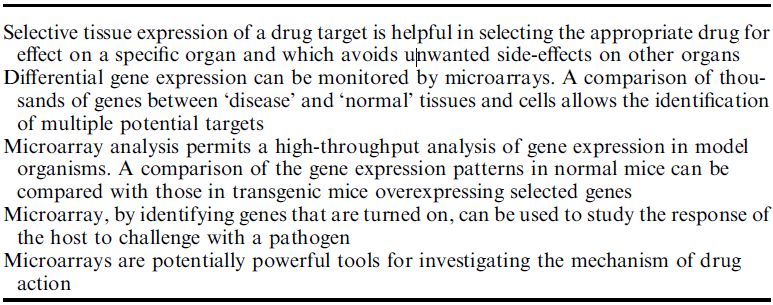


 النبات
النبات
 الحيوان
الحيوان
 الأحياء المجهرية
الأحياء المجهرية
 علم الأمراض
علم الأمراض
 التقانة الإحيائية
التقانة الإحيائية
 التقنية الحيوية المكروبية
التقنية الحيوية المكروبية
 التقنية الحياتية النانوية
التقنية الحياتية النانوية
 علم الأجنة
علم الأجنة
 الأحياء الجزيئي
الأحياء الجزيئي
 علم وظائف الأعضاء
علم وظائف الأعضاء
 الغدد
الغدد
 المضادات الحيوية
المضادات الحيوية|
Read More
Date: 21-1-2021
Date: 15-12-2020
Date: 15-1-2021
|
Biochips and Microarrays for Drug Discovery
Biochip is a broad term indicating the use of microchip technology in molecular biology and can be defined as arrays of selected biomolecules immobilised on a surface. DNA microarray is a rapid method of sequencing and analysing genes. An array is an orderly arrangement of samples. The sample spot sizes in microarray are usually less than 200 mm in diameter. It is comprised of DNA probes formatted on a microscale (biochips) plus the instruments needed to handle samples (automated robotics), read the reporter molecules (scanners) and analyse the data (bioinformatic tools).
1. Finding Lead Compounds
With an emphasis on functional genomics rather than sequencing, drug discovery programmes are using custom chips to find lead compounds. It has already been shown that it is possible to treat cells with compounds and compare the resulting patterns of gene expression with patterns previously obtained when treating cells in known ways, thereby identifying which proteins or targets the compound is altering. Such in vitro target identification should greatly improve the inefficient conventional methods of developing drugs. Because animal testing of compounds is
expensive, time consuming and has other negative aspects, DNA microarrays are likely to improve the efficiency of drug discovery by supplementing the information obtained by traditional animal testing.
2. High-throughput cDNA Microarrays
High-throughput gene expression analysis is playing an important part in the drug discovery process in a genomic-oriented atmosphere. This requires an ability to survey and compare rapidly gene expression levels between reference and test samples. In this setting, microarray technology is exploiting collections of known sequences to pinpoint drug targets.
Assay miniaturisation and microfluidics have shown promise in highthroughput screening. Microfluidic lab-on-a-chip technology has been widely used to provide small volumes and fluid connections and could eventually outperform conventionally used robotic fluid handling.8
3. Use of Gene Expression Data to Find New Drug Targets
Comprehensive gene expression analysis data and powerful computational methods coupled with appropriate genetically modified organisms can be used to decipher the function of previously uncharacterised genes.
Comprehensive gene expression profiles of cells have been used to generate databases with a wide variety of phenotypes and following different chemical treatments through the accurate and systematic analysis of gene expression en masse. Such compendia of gene expression profiles were used as a pattern matching tool to identify novel gene functions and to understand the biochemical basis of drug action. This approach can be applied for drug discovery and development. Gene expression data highlight meaningful differences between normal and disease-related genes and document the effects of drugs on gene function.
Gene expression analysis is the first new technology to be applied for many steps in the drug development process. Microarrays are being used
Table . Role of microarrays in drug discovery.

for genome-wide expression monitoring, large-scale polymorphism screening and mapping. These technologies permit the measurement of gene expression components of disease and the identification of promising new drug targets. Drug target validation and identification of secondary drug target effects can be facilitated by using DNA microarrays.
Gene chip technology also provides a method of predicting sideeffects of drugs and choosing those for development that have minimal or no adverse effects. Several ways in which microarray analysis is likely to affect drug discovery are listed in Table .
Gene expression analysis has an important application in analysis of signalling pathways of relevance to cancer and inflammation for drug target evaluation. Since activation of signalling pathways leads to mRNA expression, parallel measurement of mRNA expression is the most practical method of determining if a gene is expressed or not.
4. Investigation of the Mechanism of Drug Action
Analysis of genes can contribute to determination of the mechanism of action of a drug. Several events are triggered by the initial action of a drug. The ability to screen thousands of genes simultaneously may help in the identification of potential drug effectors. This allows the formulation of sound hypotheses of mechanism of action of drugs to be formed and tested in subsequent investigations.



|
|
|
|
4 أسباب تجعلك تضيف الزنجبيل إلى طعامك.. تعرف عليها
|
|
|
|
|
|
|
أكبر محطة للطاقة الكهرومائية في بريطانيا تستعد للانطلاق
|
|
|
|
|
|
|
العتبة العباسية المقدسة تبحث مع العتبة الحسينية المقدسة التنسيق المشترك لإقامة حفل تخرج طلبة الجامعات
|
|
|